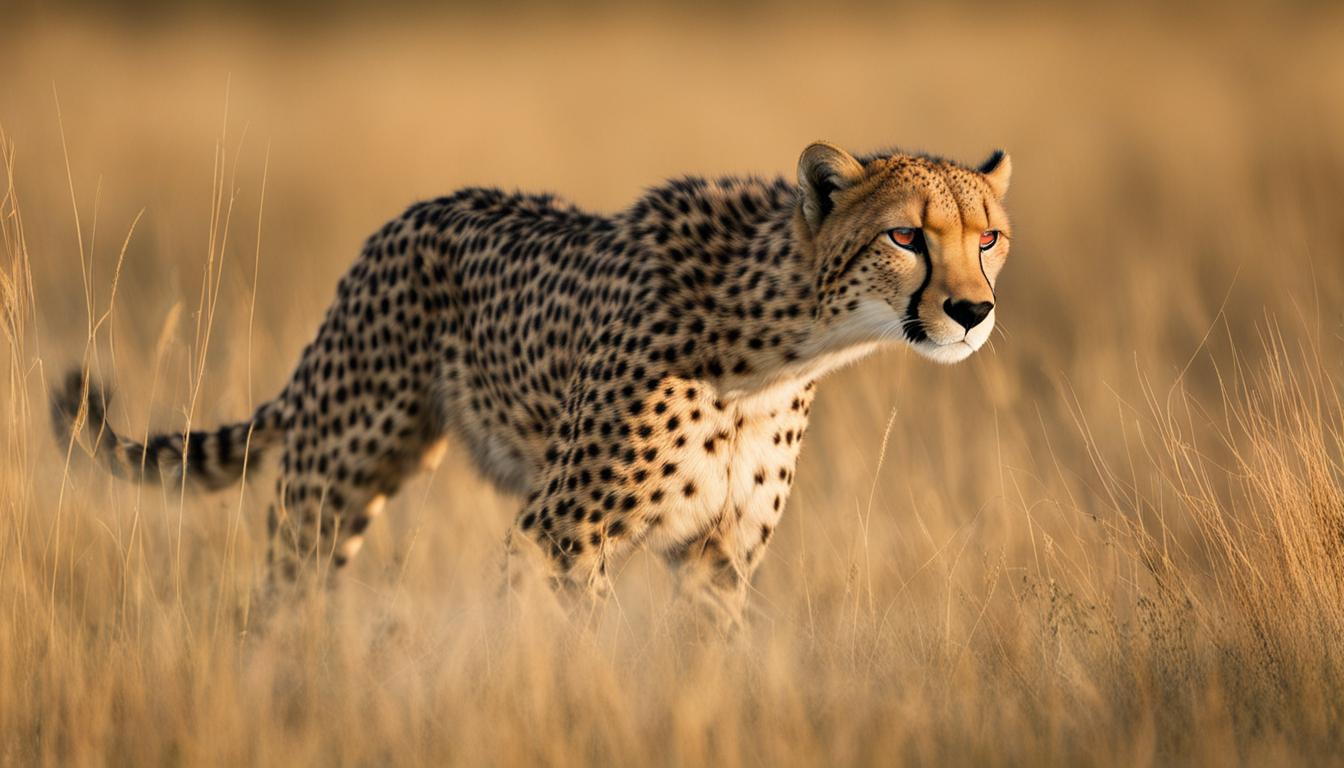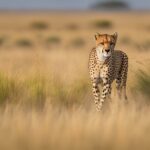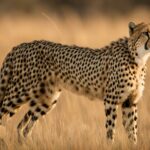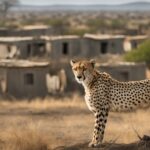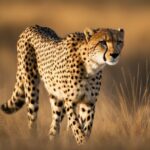When it comes to hunting, cheetahs are masters of strategy and technique. They employ a variety of tactics to ensure a successful hunt and secure their next meal. By understanding the hunting strategies of these majestic creatures, we can gain insights into their remarkable abilities and appreciate their place as one of the most fascinating predators in the animal kingdom.
From coordinating their efforts in groups to carefully selecting their prey, cheetahs exhibit a unique combination of skills when it comes to hunting. In order to maximize their chances of success, cheetahs rely on effective hunting techniques that have been honed over generations.
Male cheetah groups, for example, often employ a tactic where one male initiates the hunt while others join in. They strategically chase different ungulates, only converging when one succeeds. By adopting this cooperative approach, cheetahs increase their chances of a successful hunt.
In addition to coordinating their efforts, cheetahs also rely on their keen observation skills. They carefully scan their surroundings for any potential threats or competitors before deciding to embark on a hunt. This ensures that they have the necessary space and resources to secure their prey.
Once a suitable prey has been identified, cheetahs utilize vantage points such as termite mounds or tree branches to spot their target. They patiently wait for the opportune moment to strike, whether it’s a group of antelope moving in their direction or a herd that can be approached slowly while the prey members stand and watch.
When the time is right, cheetahs unleash their incredible speed and acceleration. Closing in on their prey within a sprinting range of 50 meters or less, they rely on their impressive agility to swiftly navigate obstacles and make precise maneuvers.
It’s not just their physical abilities that make cheetahs formidable hunters. Research suggests that they also possess the unique ability to anticipate the escape tactics of different prey species. By mirroring the prey’s specific tactics, cheetahs are able to maintain their speed and agility, increasing their chances of a successful chase.
Overall, the hunting tactics of cheetahs are a testament to their adaptability and remarkable physiological abilities. By studying and understanding these strategies, we can work towards ensuring the continued existence of these magnificent creatures in the wild.
Observation of a Cheetah Hunting in the Wild
When cheetahs embark on a hunting expedition, they employ a unique set of techniques to ensure a successful catch. Observations of cheetahs in the wild have revealed fascinating insights into their hunting strategy. One of the key aspects of their approach is the use of vantage points to survey the surrounding terrain for potential prey. Cheetahs often position themselves atop termite mounds or tree branches, allowing them to spot their quarry from a distance.
From these advantageous positions, cheetahs patiently wait for an opportune moment to strike. If they observe a group of antelope moving in their direction, they may remain at their vantage point, biding their time until the prey members come within range. Alternatively, they may slowly approach a herd while the prey members stand watchfully, unaware of the impending danger. This meticulous planning and observation demonstrate the cheetah’s methodical approach to hunting.
Once the cheetah has determined the perfect moment to initiate the chase, it uses its remarkable speed and acceleration to its advantage. Getting within sprinting range, typically 50 meters or less, the cheetah launches into a lightning-fast pursuit. With each stride, the cheetah propels itself forward, racing towards its agile prey with unmatched agility and grace.
| Advantages of Cheetah Hunting Technique | Challenges for Cheetahs |
|---|---|
| Exceptional speed and acceleration | Short bursts of energy |
| Strategic use of vantage points | Need for close proximity before chase initiation |
| Effective coordination within groups | Presence of kleptoparasites like hyenas |
“Cheetahs employ a unique hunting strategy that involves careful observation, incredible speed, and calculated precision. By utilizing vantage points and selecting the optimal moment to strike, cheetahs maximize their chances of a successful hunt.”
In conclusion, the observation of cheetahs hunting in the wild provides valuable insights into their exceptional hunting techniques. From strategic use of vantage points to their impressive speed and agility, cheetahs showcase a remarkable ability to adapt and thrive in their natural environment. Understanding and appreciating these hunting strategies allows us to marvel at the magnificence of these awe-inspiring predators.
Cheetahs Anticipate Prey’s Escape Tactics
When it comes to hunting, cheetahs are not just reliant on their incredible speed and agility. Research has shown that they also possess an impressive ability to anticipate the escape tactics of their prey. This strategic thinking allows cheetahs to stay one step ahead and increase their chances of a successful hunt.
During a chase, cheetahs employ a two-phase approach. The first phase involves a rapid acceleration to catch up with the prey, utilizing their explosive bursts of speed. But it is in the second phase that their anticipation skills truly shine. Cheetahs actively slow down to mirror the prey’s specific escape tactics, matching every twist and turn with precision.
This adaptive hunting behavior is crucial for cheetahs to overcome the agility of their prey. By effectively predicting and mirroring the movements of different species, cheetahs can maintain the optimal position to close in on their targets. This anticipation allows them to conserve energy and make calculated decisions during the chase.
The Power of Observation
How do cheetahs develop this remarkable ability? It all starts with keen observation. Cheetahs carefully observe the behavior of their prey, learning their escape patterns and strategies. By studying and understanding their prey’s tactics, cheetahs can adjust their own hunting methods accordingly.
These observations are not limited to a single prey species. Cheetahs have been observed hunting various ungulates, each with its own unique characteristics and escape strategies. By adapting their tactics to match the specific prey they are pursuing, cheetahs increase their success rate and maximize their chances of a successful hunt.
In conclusion, the ability of cheetahs to anticipate and mirror their prey’s escape tactics is a testament to their exceptional hunting prowess. Their strategic thinking and adaptability make them one of the most successful predators in the animal kingdom. By studying and appreciating the hunting strategies of these magnificent creatures, we can gain a deeper understanding of their role in the ecosystem and work towards their conservation.
The Physiology and Hunting Tactics of Cheetahs
When it comes to hunting, cheetahs utilize a combination of physiological adaptations and strategic tactics to ensure successful hunts. Their hunting strategies are not limited to mere speed and agility. Cheetahs engage in a complex duel of speed, acceleration, and rapid turns, adapting their tactics based on the specific prey they are targeting.
One key aspect of cheetah hunting tactics is the balance between speed and agility. The cheetah’s incredible acceleration allows it to reach speeds of up to 70 miles per hour in just a few seconds. This speed is crucial for closing the distance between the cheetah and its prey, enabling it to get within sprinting range before initiating a chase.
Another intriguing aspect of cheetah hunting is their ability to anticipate the escape tactics of different prey species. Research suggests that cheetahs actively slow down during a chase to mirror the prey’s specific escaping tactics. This slowing period allows the cheetah to match the prey’s turns, increasing the chances of a successful capture.
To summarize, cheetah hunting tactics involve a combination of speed, acceleration, braking, and rapid turns. They adapt their strategies to match the specific prey they are hunting, showcasing their remarkable physiological abilities. By studying and understanding these hunting tactics, we can gain valuable insights into the behavior and adaptations of these fascinating predators.

The Physiology and Hunting Tactics of Cheetahs
Conclusion
The cheetah’s hunting strategy is a unique combination of coordination among group members, careful selection of prey, and the anticipation of prey’s escape tactics. By understanding and studying the hunting tactics of these magnificent animals, you can work towards ensuring their continued existence in the wild.
Cheetahs’ ability to adapt their hunting strategies showcases their remarkable physiological abilities and makes them one of the most fascinating predators in the animal kingdom. Their agility, speed, and precision in hunting are unparalleled.
As you delve deeper into the intricacies of cheetah hunting, you realize the importance of space, coordination, and prey awareness in their hunting success. Each aspect of their strategy is finely tuned, allowing them to optimize their chances of capturing prey.
How Does a Cheetah’s Vision Impact Their Hunting Tactics?
The role of vision in cheetah hunting is crucial, as their keen eyesight allows them to spot prey from far distances. This exceptional vision helps them strategize their approach, enabling them to stalk and pursue their target with precision and speed. Their ability to focus on moving objects gives them a distinct advantage in the savanna landscape.
Do Cheetahs Use Their Sprinting Ability as a Hunting Tactic or for Energy Conservation During a Chase?
Cheetahs utilize their unmatched cheetah sprinting and energy conservation abilities as a hunting tactic. Their outstanding speed is crucial for catching prey, allowing them to swiftly close the distance and overwhelm their target. After a short, intense burst of speed, they must conserve energy during the chase to ensure a successful hunt.
FAQ
What are the tactics cheetahs use when hunting for prey?
Cheetahs coordinate their hunting efforts in groups and require adequate space to hunt. They scan the area for other predators before deciding to hunt. Some tactics employed by male cheetah groups include one male initiating the hunt while others join in, chasing different ungulates and converging when one succeeds, or chasing different antelopes simultaneously. They strategically choose their targets based on prey availability and the presence of kleptoparasites like hyenas.
How do cheetahs approach their prey?
Cheetahs often utilize vantage points like termite mounds or tree branches to spot potential prey. They may wait at a vantage point if a group of antelope is moving in their direction. They can also approach a herd slowly while the prey members stand and watch. The cheetah’s hunting strategy involves getting within sprinting range (50m or less) of the prey before initiating a chase. Their incredible speed and acceleration allow them to catch their agile prey.
Do cheetahs anticipate the escape tactics of their prey?
Research suggests that cheetahs not only rely on their speed and agility but also anticipate the escape tactics of different prey species. They first accelerate towards their quarry, then actively slow down to mirror prey-specific escaping tactics. Cheetah chases consist of two primary phases – an initial rapid acceleration to catch up with the prey and a prey-specific slowing period that allows them to match the prey’s turns. The amount of power and effort put into a chase is determined by the prey species.
Are cheetahs’ hunting tactics only about speed?
No, cheetahs’ hunting tactics are not limited to high-speed dashes. They engage in a complex duel of speed, acceleration, braking, and rapid turns with different ground rules depending on the prey they are hunting. For successful hunts, cheetahs exhibit more turning at the end of the chase. Their hunting efforts involve a balance between speed and agility, adapting their strategy to match the specific prey.
What makes cheetahs unique hunters?
The cheetah’s hunting strategy is a unique combination of coordination among group members, careful selection of prey, and the anticipation of prey’s escape tactics. By understanding and studying the hunting tactics of these magnificent animals, we can work towards ensuring their continued existence in the wild. Cheetahs’ ability to adapt their hunting strategies showcases their remarkable physiological abilities and makes them one of the most fascinating predators in the animal kingdom.

